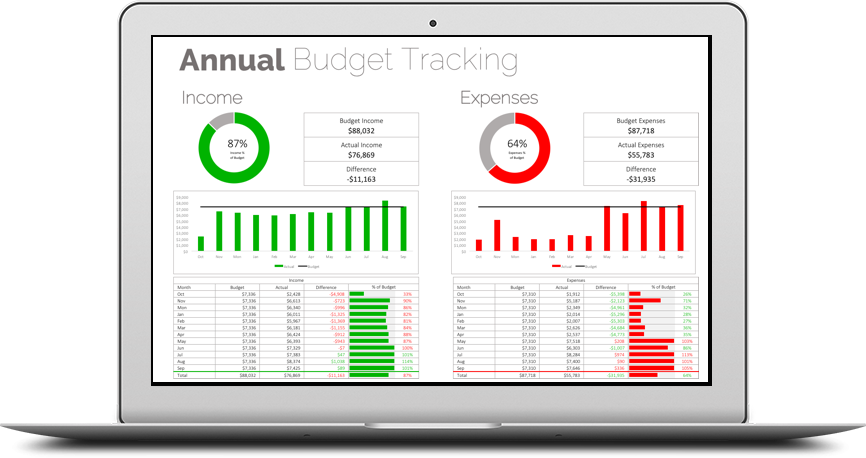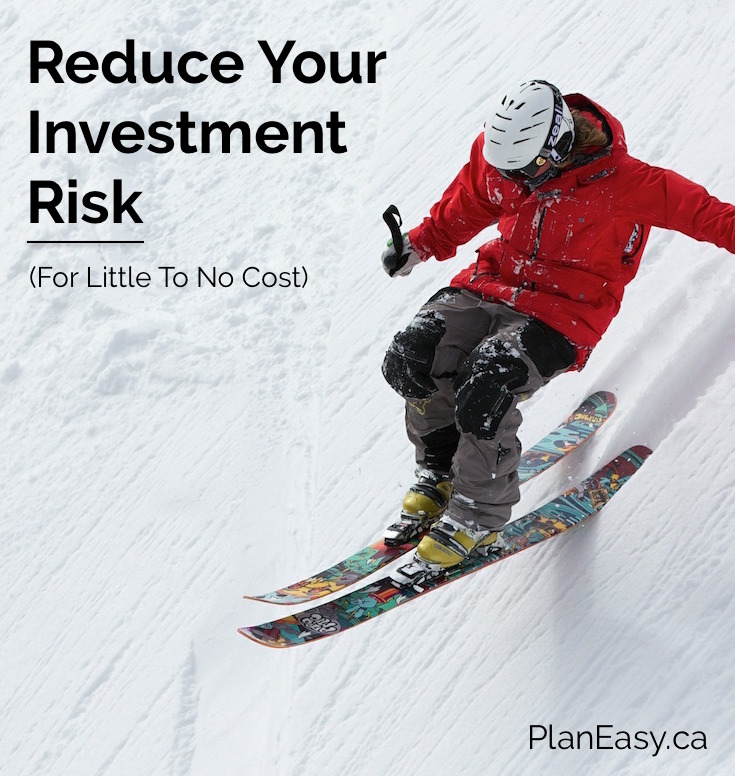Reduce Your Investment Risk
(For Little To No Cost)
Investing is risky. That’s the price you pay in exchange for higher returns.
If you wanted zero risk you’d put your money in a high interest savings account. But then your returns wouldn’t even keep up with inflation. Over the long run, a no-risk investment is essentially losing money because it’s worth less and less each year.
Buying bonds offers a slightly higher return, usually above inflation, but that comes with additional risk. Bond prices are sensitive to interest rates and the economy. There is also the risk of default.
Equities provide an even higher return. This is in exchange for much higher risk.
So how do you go about reducing your risk for little to no cost? First let’s discuss exactly what we mean by risk.
What Is Risk?
When we talk about risk we’re talking about fluctuations in your investments. An investment that fluctuates by a large amount is a higher risk. An investment that fluctuates by a smaller amount has less risk.
Example: Putting your investment into a small start-up is a large risk. Your investment can fluctuate wildly and can even go to zero. Putting your investment into a blue-chip company is less risky, your investment will be more stable but there is still a chance of your investment going down. Investing in a high interest savings account has nearly zero risk. It will never go down and is protected by the government for up to $100,000.
When investing there are two main types of risk. Systematic risk and specific risk. As an investor, it’s important to understand these risks, it’s the reason you get a higher reward.
It’s also important to understand how to reduce your risk. Reducing your risk helps smooth out the fluctuations in your portfolio. There are a few ways to reduce your risk at a very, very low cost. It’s a small price to pay to help you sleep better at night and ensure your investments will be around for the long term.

Systematic Risk:
The first type of risk is called systematic risk. Systematic risk affects many assets at once. This could be political risk, economic risk, environmental risk, industry risk etc. These risks affect many companies at the same time.
During the financial crisis, many companies were affected by the broad economic risks at the time. The entire S&P 500 fell by almost 50% in one year. Financial companies did much worse but many companies experienced a large decrease in their stock price regardless of their exposure to the affected financial companies.
Systematic risks are difficult to avoid. These risks are very broad in nature and are the main reason that equities provide a higher return than bonds or savings accounts.
To reduce the impact of systemic risks, investments can be made in multiple asset classes. Investing in equities, bonds, real estate, etc will help reduce the impact of systematic risks. Different asset classes react differently to broad systematic risks, some even go up while others go down (ie bonds vs stocks), this can help smooth your returns over time and reduce your overall risk.
ETFs provide an inexpensive way to invest in multiple asset classes. For new investors, the cost of an ETF is often less than the cost of trading individual stocks/bonds. This lets you reduce your risk at no incremental cost. You can purchase ETFs that focus on stocks or bonds or real estate or commodities or virtually any asset class you would like to invest in.
To determine the exact weight of each asset class, you should have a discussion with your financial planner. Your asset allocation will depend on your specific investment goals and risk profile.
New blog posts weekly!
Tax planning, benefit optimization, budgeting, family planning, retirement planning and more...

“Risk is good. Being risky is bad.”

Specific Risk:
The second type of risk is called specific risk. This is risk that is linked to a specific company or a small group of companies. There is risk from manufacturing costs, labor disruptions, business constraints, marketing/advertising etc.
In general, you aren’t compensated with higher investment returns for taking on specific risk. This is because specific risk is easily reduced through diversification.
Example: Let’s say you owned Starbucks stock. Starbucks is affected by higher costs for raw coffee beans. This could have a negative effect on their future earnings potential. Their profit margin might decrease from 10% to 8%, and the stock price may decline as a result. This is specific risk.
BUT. If you were diversified then you may also own a coffee grower stock. This coffee grower may benefit from an increase in raw coffee prices. This could have a positive effect on their future earnings potential. Their profit margin might increase from 10% to 12%, and the stock price may rise as a result. By owning both stocks, you reduce your specific risk and your average profit margin would stay constant at 10%.
Diversifying your investments helps reduce the impact of these specific risks. In this example, your average return would stay steady regardless of what happened to each individual investment. Through diversification you’ve been able to eliminate this fluctuation from your portfolio.
This is a simple example, and is just for illustration purposes. In practice, you need to buy many stocks to be well diversified.
Buying index ETF’s is a great and inexpensive way to diversify your investments. For new investors, the cost of an ETF is much less than making individual trades. Through an ETF you can purchase hundreds of companies at once. You can purchase hundreds of bonds at once. You can purchase hundreds of real estate properties at once. You can even purchase a global ETF that covers all major companies around the world.
Investment Risk:
Risk is good. It’s the reason you get a higher return on your investments. Just don’t take on more risk than you absolutely need to.
Through asset allocation and diversification, you can reduce your investment risk for little to no incremental cost. Using ETFs is a great way to achieve these goals but it can be done in other ways too.
Risk is good. Being risky is bad.
Join over 250,000 people reading PlanEasy.ca each year. New blog posts weekly!
Tax planning, benefit optimization, budgeting, family planning, retirement planning and more...
Join over 250,000 people reading PlanEasy.ca each year. New blog posts weekly!
Tax planning, benefit optimization, budgeting, family planning, retirement planning and more...





Risk is a funny thing – it’s completely undefinable and yet there are entire departments in different companies to mitigate those risks. I’m in credit risk, and think it’s crazy how we can confidently say, “This product is riskier than that product.” even though things never play out how we think they will.
Have you read any of Nassim Taleb’s work? I love his books – he writes on randomness and in particular, the riskiness of financial assets.
No I haven’t. Are there are particular books or articles you’d recommend?
The Black Swan and Fooled by Randonness I’ve read. He is an academic at heart, so the books are a fairly dense, but the points he makes are sound.
Great! I’ll check those out at the library. Thanks for the recommendation.